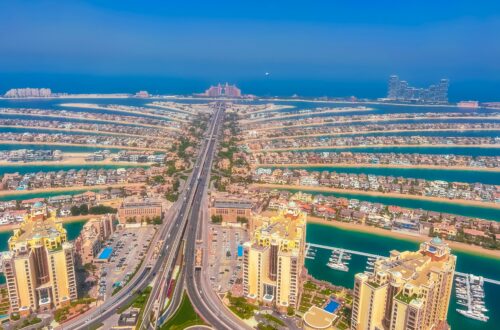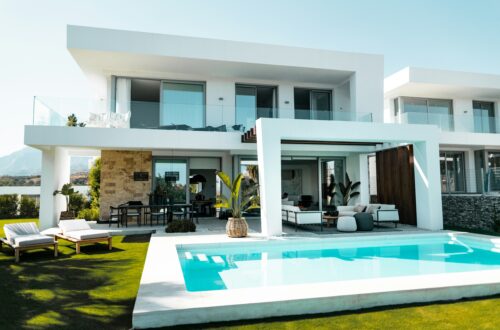You’ve got the capital, the connections, and the confidence. But even the wealthiest investors face this nagging question: What if I choose wrong?
In the UAE, the stakes are high. The market dazzles with luxury towers and prime commercial spaces, yet beneath the surface lies a brutal truth: Without a strategy, your wealth can drain faster than you realize.
So, What separates those who thrive from those who falter? One simple formula.
Why Strategy Matters: A Look at the Last Five Years
The UAE real estate market has been a playground for wealth, with over AED 300 billion in transactions in 2022 alone (source: Dubai Land Department). But here’s what the numbers don’t show:
Residential Reality: Prime locations like Palm Jumeirah saw rental yields spike to 8%, yet many high-end purchases failed to even cover operational costs.
Commercial Complexity: While office spaces in Business Bay became goldmines, poorly negotiated leases left other investors struggling to break even.
Missed Opportunities: Inconsistent data analysis led to over-investments in markets like JLT, where rental demand lagged behind supply.
The lesson is clear: The market rewards precision, not impulse.
Introducing the 1% Rule: Your Profitability Check
The 1% Rule is the ultimate litmus test for your next investment. Here’s how it works:
Monthly Rent ≥ 1% of Purchase Price
Let’s break it down:
A property priced at AED 3 million must generate AED 30,000/month in rent to meet this benchmark.
Anything less means the property is likely underperforming.
But here’s the kicker: In a market as dynamic as the UAE, simply applying this rule isn’t enough. Where you apply it and how: makes all the difference.
Why Not All Properties Fit the 1% Rule
Even in dynamic markets like Dubai, luxury properties often struggle to meet the 1% benchmark due to inflated purchase prices. Commercial spaces, however, have begun to outshine residential investments in 2025. Why?
Increased Corporate Demand: UAE’s tax incentives attract multinational corporations.
Stable Long-Term Leases: Businesses prioritize prime locations, offering predictable rental income.
Flexible Space Usage: Commercial properties adapt easily to coworking and hybrid setups, increasing demand.
Collecting Neighborhoods Where the 1% Rule Thrives
1. Jumeirah Village Circle (JVC)
Why is JVC a Goldmine?
- Affordable properties with strong rental demand from families and young professionals.
- Recent infrastructure improvements have made JVC more accessible, increasing its rental appeal.
Case Study:
- Studio Purchase Price: AED 800,000
- Monthly Rent: AED 8,500 (1.06%)
- Insight: Studios and 1-bedroom apartments consistently meet the 1% benchmark due to their affordability and demand.
2. Business Bay
Why Does Business Bay Dominate Commercial Investing?
- Central location attracting multinational corporations.
- A surge in flexible workspace models, driving rental demand.
Case Study:
- Office Space Purchase Price: AED 5 million
- Monthly Rent: AED 55,000 (1.1%)
- Insight: High occupancy rates and long-term lease agreements ensure predictable income streams.
3. Downtown Dubai Retail Spaces
The Retail Advantage:
- Proximity to tourist hotspots like Burj Khalifa guarantees steady foot traffic.
- Retail spaces here command premium rents, often exceeding 1% yields.
Case Study:
- Retail Space Purchase Price: AED 10 million
- Monthly Rent: AED 125,000 (1.25%)
- Insight: Exclusive leases with global brands provide stability and consistent returns.
Buying Right: How to Secure Profits Before Selling?
1. Use Data to Strengthen Offers: Present rental yield comparisons from platforms like Bayut and Knight Frank to justify lower offers.
2. Focus on Value-Add Opportunities: Negotiate down prices for properties needing cosmetic upgrades.
3. Seek Off-Market Listings: Off-market properties often come with less competition and better terms.
4. Capitalize on Bulk Discounts: Purchase multiple units in a development to secure significant price reductions.
5. Negotiate Flexible Payment Plans: Developers often offer installment plans for off-plan properties.
6. Target Sellers in Need of Quick Liquidation: Sellers under financial pressure are more open to negotiations.
7. Highlight Overlooked Costs: Use future maintenance or service charge estimates to negotiate price reductions.
Advanced Strategies for 2025
1. Sharia-Compliant High-Yield Investments
For investors adhering to Islamic principles, Sharia-compliant investments provide lucrative opportunities without involving Riba (interest). Equity-based models, such as joint ownership in high-demand commercial properties, are gaining traction across the UAE. These investments allow you to share profits proportionally while maintaining full compliance with Islamic finance principles.
A prime example is co-investing in serviced offices in Business Bay, where demand consistently outstrips supply. By partnering with other investors, you can acquire larger assets, ensuring better rental yields while spreading the risk. This strategy aligns wealth-building with values, making it an ethical and profitable choice.
2. Hidden Gems: Secondary Markets with High Yields
While prime areas like Downtown Dubai dominate the spotlight, secondary markets like Dubai South and Arjan are quietly delivering impressive returns. These emerging neighborhoods offer lower entry points, making them ideal for investors seeking affordability without compromising yield.
For instance, properties in Dubai South, near the Expo 2025 site, are projected to experience rental demand surges as new infrastructure boosts connectivity. Similarly, Arjan’s strategic location near Dubai Miracle Garden and affordable residential developments make it a hotspot for young professionals and families.
3. The Power of Mixed-Use Developments
Mixed-use developments blend residential, commercial, and leisure spaces, creating self-sustained communities that attract diverse tenant bases. These properties are particularly valuable in Dubai Hills Estate and Al Barsha South, where convenience drives demand.
Investing in mixed-use spaces ensures dual revenue streams. For example, a retail shop below a residential tower generates steady income from local residents. This duality enhances the asset’s resilience to market fluctuations, ensuring more consistent returns over time.
4. Understanding Long-Term Leases in Prime Locations
Corporate tenants prioritize stability, making long-term leases in areas like DIFC and Business Bay highly attractive. These agreements often include annual escalation clauses, ensuring steady rental income growth.
Such leases reduce turnover costs and eliminate the uncertainty associated with finding new tenants. For example, office spaces in DIFC leased to multinational corporations provide guaranteed income for 5–10 years, making them a cornerstone for HNWIs seeking low-risk investments.
5. Leveraging Free Zones for Commercial Property Investment
Free zones like Jebel Ali Free Zone (JAFZA) and Dubai Internet City are magnets for international businesses due to their tax benefits and streamlined regulations. Investing in properties here means tapping into a high-demand pool of tenants looking for operational ease.
These properties often yield above-market rental returns due to their exclusivity and specialized clientele. For instance, office spaces in JAFZA leased to logistics companies cater to Dubai’s growing position as a global trade hub, ensuring high demand and minimal vacancy.
6. Off-Plan Properties: The Risk-Reward Balance
Off-plan properties remain an excellent way to enter the market at discounted prices, provided you choose reputable developers. These investments typically offer installment-based payment plans, reducing initial capital outlay.
The reward lies in post-completion yields, often exceeding 1% benchmarks due to high demand. However, thorough due diligence is crucial to avoid risks like project delays or market saturation. Areas like Mohammed Bin Rashid City (MBR City) currently offer promising off-plan opportunities with robust developer track records.
Conclusion: Build Wealth with Precision
Real estate investing isn’t just about owning property. It’s about owning the right property in the right place, with the right strategy. By leveraging the 1% Rule, targeting emerging markets, and adopting advanced investment strategies, you position yourself for sustainable success in one of the world’s most dynamic real estate hubs.
What’s your approach to UAE’s real estate market? Are you focusing on residential growth, commercial dominance, or a mix of both? Share your thoughts below, and let’s explore the strategies that define successful investments. Your insights could inspire the next big discussion!






